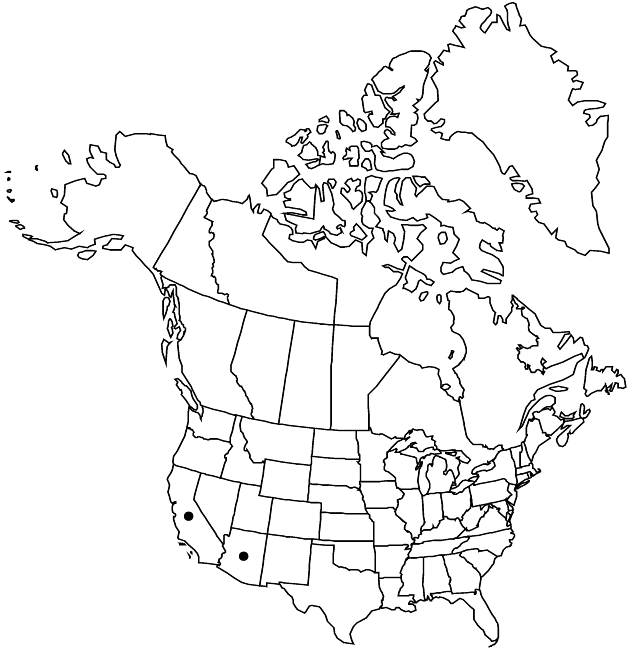Difference between revisions of "Helianthus niveus subsp. tephrodes"
Mem. Torrey Bot. Club 22(3): 43. 1969.
FNA>Volume Importer |
imported>Volume Importer |
||
| (5 intermediate revisions by 2 users not shown) | |||
| Line 8: | Line 8: | ||
}} | }} | ||
|common_names=Algodones or Algodones dunes sunflower | |common_names=Algodones or Algodones dunes sunflower | ||
| − | |basionyms={{Treatment/ID/ | + | |special_status={{Treatment/ID/Special_status |
| + | |code=C | ||
| + | |label=Conservation concern | ||
| + | }} | ||
| + | |basionyms={{Treatment/ID/Basionym | ||
|name=Helianthus tephrodes | |name=Helianthus tephrodes | ||
|authority=A. Gray | |authority=A. Gray | ||
| + | |rank=species | ||
| + | |publication_title=in W. H. Emory, Rep. U.S. Mex. Bound. | ||
| + | |publication_place=2(1): 90. 1859 | ||
}} | }} | ||
|synonyms= | |synonyms= | ||
| Line 38: | Line 45: | ||
-->{{#Taxon: | -->{{#Taxon: | ||
name=Helianthus niveus subsp. tephrodes | name=Helianthus niveus subsp. tephrodes | ||
| − | |||
|authority=(A. Gray) Heiser | |authority=(A. Gray) Heiser | ||
|rank=subspecies | |rank=subspecies | ||
| Line 52: | Line 58: | ||
|publication title=Mem. Torrey Bot. Club | |publication title=Mem. Torrey Bot. Club | ||
|publication year=1969 | |publication year=1969 | ||
| − | |special status= | + | |special status=Conservation concern |
| − | |source xml=https:// | + | |source xml=https://bitbucket.org/aafc-mbb/fna-data-curation/src/2e0870ddd59836b60bcf96646a41e87ea5a5943a/coarse_grained_fna_xml/V19-20-21/V21_364.xml |
|tribe=Asteraceae tribe Heliantheae | |tribe=Asteraceae tribe Heliantheae | ||
|subtribe=Asteraceae (tribe Heliantheae) subtribe Helianthinae | |subtribe=Asteraceae (tribe Heliantheae) subtribe Helianthinae | ||
Latest revision as of 20:11, 5 November 2020
Annuals or perennials, 50–150 cm (taproots stout). Stems erect or decumbent, sericeo-villous (hairs white). Leaves mostly cauline; mostly alternate; petioles 1.5–3.5 cm; blades deltate or deltate-ovate, 3–7 × 2–4 cm, bases cuneate, margins entire or serrulate, abaxial faces densely sericeous, gland-dotted. Heads 1–3. Peduncles 4–17 cm. Involucres hemispheric, 8–28 mm diam. Phyllaries 18–21, lanceolate, 8–10 × 1–3.5 mm, apices shortly attenuate, abaxial faces densely white-canescent. Paleae 8–11 mm, subentire to 3-toothed. Ray florets 10–13; laminae 16–25 mm. Disc florets 50+; corollas 4.5–6 mm, lobes reddish; anthers brownish red, appendages reddish (style branches reddish). Cypselae 4–8 mm, ± villous; pappi of 2(–3) lanceolate scales 1.5–3 mm plus 2–4 obtuse scales 0.5–1 mm. 2n = 34.
Phenology: Flowering fall–spring.
Habitat: Sand hills
Elevation: 50–300 m
Distribution

Ariz., Calif., Mexico (Sonora).
Discussion
Of conservation concern.
Subspecies tephrodes differs from subsp. niveus, which is not known to occur north of Mexico, by having less densely hairy phyllaries and generally broader leaves (larger leaves more than 3 cm broad). Both differ from H. petiolaris subsp. canescens (H. niveus subsp. canescens) by lacking the conspicuous white-villous tufts (“beard”) of the median cusp of the paleae in the center of the head that characterize H. petiolaris.
Subspecies tephrodes is in the Center for Plant Conservation’s National Collection of Endangered Plants.
Selected References
None.